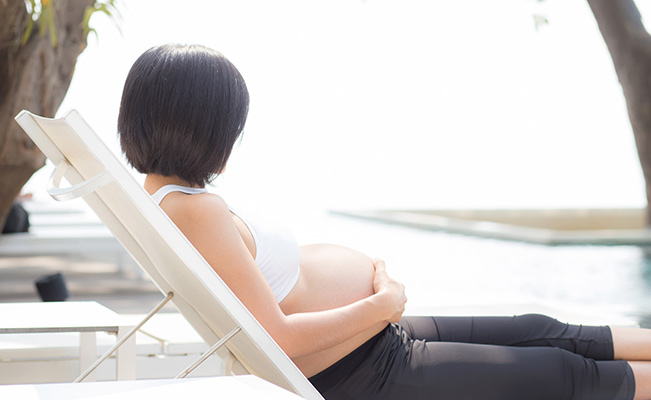
Water is the symbol of peace and calm. As early as the ancient times, water, especially when warm, has been utilized to relieve stress and manage pain. And even now in the modern times, people have been utilizing the benefits of warm water: drinking for digestion, bathing for relaxation, and as a natural alternative for birth.
There has been an emerging trend on water birth, especially for mothers who seek a relaxing, calm, and natural birthing experience. According to the International Childbirth Education Association in 20151, water birth historically has been used by Japanese women who utilized warm birthing pools to manage labor pain. British midwives also used warm water to help alleviate the pain in a laboring woman.
What are the benefits of water birth?
The water birth’s main benefit is helping the mother to relax, especially during labor. But, it also offers other great advantages such as:
- It helps the mother feel comforted, calm, and relaxed during the whole experience2.
- The mother feels more satisfied with the birth1.
- They feel more flexible in assuming labor and birth positions due to the buoyancy1.
- It reduces the mother’s need for medicinal pain relievers after the birth3.
- The mother may experience a shorter and easier labor4.
- This natural birthing method helps improve the blood flow, which reduces fetal distress4.
- It reduces perineal trauma and the risk of having episiotomy5.
What are the risks of water birth?
Just like any other birthing methods, water birth also entails some risks. For mothers who are seeking out this birthing method, you should consult with your medical provider first.
- Infection. It can originate from these two sources: the germs from the mother’s body and the germs present in the water.
- Water temperature. It is highly important that the water should be maintained at a temperature similar to the body’s natural heat (around 32-38°C)6 to prevent undue stress7.
- Mishandling of the umbilical cord. Parents should make sure that a midwife or medical professional is present during the water birth to avoid tearing of the umbilical cord, and assist in its untangling in case the cord is wrapped around the child’s neck7.
What happens during water birth?
Basically, the mother submerges herself into a pool or tub filled with warm water. And during water birth, the mother has the option to either complete the whole water birthing experience by delivering in the tub or pool, or just do a water immersed labor to help manage labor pains.
Am I fit to do a water birth?
Before you decide if water birth is the way to go, here are some things you should know:
- The mother should not have any diseases that can easily be transferred in water, such as Herpes8.
- The child should be positioned headfirst in the uterus. Delivering a child in a breech position poses a lot of risk to both the child and the mother8.
- The mother should also avoid water birth if they have a high risk pregnancy such as preeclampsia8.
- If the mother is expecting multiples, such as twins, it is advisable to discuss with a doctor the potential risks of delivering by waterbirth8.
- If there is an expected preterm labor, water birth is highly discouraged8.
- The mother should not have any chronic medical conditions such as high-blood and diabetes9.
Modern mothers are now becoming more and more open to trying out natural birthing plans to ensure the safe delivery of their child. So, if you are an expecting mother who wants to experience a natural, calm, and soothing birthing experience, you should definitely consider water birth!
But, as a gentle reminder for parents, you should first consult your birthing method with a trusted doctor to thoroughly discuss the risks and how to avoid them.
And to lend you a hand in this amazing journey of parenthood, join Club Mama today to unlock a world of privileges and benefits which include free samples, exclusive vouchers, promotions, expert advice and many more!
References:
1 Water Labor & Water Birth. Retrieved September 13, 2020 from: https://icea.org/wp-content/uploads/2016/01/Water_Birth_PP.pdf
2 Water Births. Retrieved September 13, 2020 from: https://americanpregnancy.org/labor-and-birth/water-births-658
3 Cluett, E. and Burns, E. (2009) Immersion in water in labour and birth. Cochrane Database Systematic Review Issue 2, N0. CD000111. URL: https://pubmed.ncbi.nlm.nih.gov/19370552/
4 Benefits of Water Birth. Retrieved September 13, 2020 from: https://www.ohsu.edu/womens-health/benefits-water-birth
5 Dahlen, H.G. et al. (2013) Maternal and perinatal outcomes amongst low risk women giving birth in water compared to six birth positions on land. A descriptive cross sectional study in a birth centre over 12 years. Midwifery, Jul, 29(7):759-64. URL: https://pubmed.ncbi.nlm.nih.gov/22884894/
6 About Waterbirth. Retrieved September 13, 2020 from: https://waterbirth.org/faqs/
7 Water Birth Risks and Safety Concerns. Retrieved September 13, 2020 from: https://www.ohsu.edu/womens-health/water-birth-risks-and-safety-concerns
8 Water Births. Retrieved September 13, 2020 from: https://americanpregnancy.org/labor-and-birth/water-births-658
9 Alternative Birthing: Is It Safe? Retrieved September 13, 2020 from: https://www.winchesterhospital.org/health-library/article?id=101214
